Introduction
The ATH-DSR7BT and the ATH-DSR9BT are differentiated from the multitude of Bluetooth over-ear headphones available from various manufacturers by not only the Pure Drive electronics which maintains an audio signal that is completely digital from the audio source to the drivers, with no analog electronics in the path, but also by their qualification for the High-Resolution Audio mark given to audio equipment that can reproduce audio encoded at a typical minimum 96 kHz sample rate of 24 bit data and a minimum upper frequency of 40 kHz.
The ATH-DSR7BT competes by price, if not features, with the JBL Everest Elite 750NC, the BOSE SoundLink II, the BOSE QuietComfort 35 II, the Sennheiser HD 4.50 BTNC, and the V-Moda Crossfade II in the around $200 to $300 range. I could not try all of these headphones, but purchased the A-Ts after trying the JBL and Sennheiser, -- and being familiar with the BOSE's excellent but unnatural sound -- primarily because they provide high quality audio, balanced throughout the frequency spectrum allowing nuances in the music and textures in the tones produced by instruments to be clearly heard -- the single most important feature to me in headphones. The $170 Black Friday discount at Best Buy on the regular $299 price also helped, although I wouldn't have purchased then without the balanced sound.
Technology Highlights
The technology used in these headphones seems to be unique and at the vanguard of audio equipment technology with respect to a completely digital signal provided by the Pure Drive technology, and at the same time, old -- while technically superior to the widely adopted low quality formats -- with respect to High-Resolution Audio which, according to some critics, is an attempt to re-market higher than CD quality digital music where such attempts had previously failed. This time referred to as High-Resolution Audio, Hi-Res Audio, or HRA, it is currently more feasible to promote the bandwidth and storage resource intensive high resolution audio since the first attempts in the mid 1990s on physical media.
High Resolution Audio
High-Resolution Audio is partly formally defined by Recommendations for Hi-Resolution Music Production by The Recording Academy's Producers and Engineers Wing. In general, it defines that audio equipment must be able to reproduce audio at higher than CD quality, which is encoding at 16 bit sampling at 44 kHz. According to A-T, this typically means 24 bit sampling at 96 kHz.
To benefit from HI-Res Audio, the source must be encoded in an uncompressed format such as WAV or AIFF, or lossless compressed formats such as FLAC and ALAC. And specifically for these A-T headphones, a USB cable (a high quality shielded USB cable is included) must be used to make a connection to the source player.
I downloaded excerpts of the song Bee Moved encoded in 16bit/48kHz M4A and 24bit/96kHz FLAC from Sony for comparison. Each excerpt was 39.894 seconds of the same part of the song, with the M4A taking 1.3 MiB and the FLAC taking 15.9 MiB of storage. After listening to these files using Audacity, I couldn't tell the difference between the two. To my ears, both files equally displayed the characteristics of Hi-Res Audio, which according to this Sony page are:
- "Output is in an extended high-frequency range."
- "Multiple instruments and overlapping sounds are clearly discernible."
- "Even sounds beginning to fade away, reverberate, and finally trail off into the air are reproduced."
- "Minute sounds are clearly perceptible."
- "Subtle characteristics of the atmosphere at the time of recording are reproduced."
- "Even the subtle breathing of vocalists comes through."
A-T has numerous Hi-Res Audio headphones in its various lines as does for example, Sony, and the V-Moda Crossfade II are Hi-Res Audio certified, however none of the Sony headphones nor the V-Moda Crossfade II employ completely digital signal electronics. And it seems that other manufacturers are not producing headphones that conform to the Hi-Resolution Audio guidelines near the price range of these headphones.
Pure Drive Digital Audio
The really new and unique feature, as far as I know, is the completely digital signal from the audio source to the drivers without a digital to analog converter or an analog amplifier in the path. This is achieved through the use of A-T's Pure Digital Drive, a technology enabled by Trigence Semiconductor's Dnote Pure Digital Sound System.
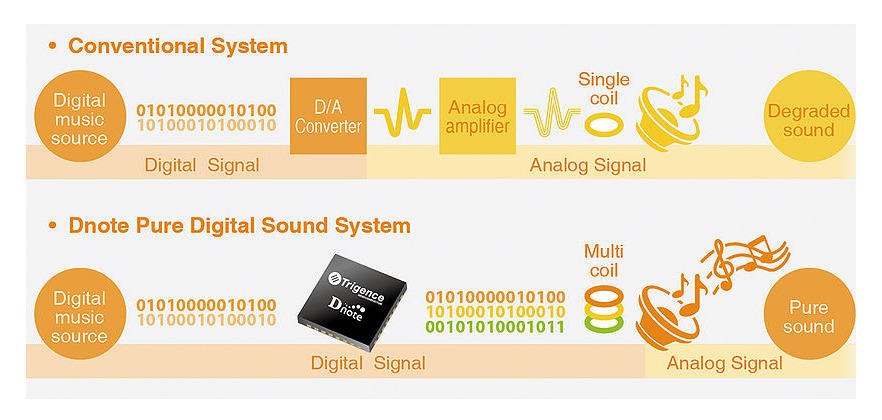
A Comparison of Conventional Audio Technology and Completely Digital Technology
Reproduced from
Trigence Semiconductor. Note the lack of a digital to analog converter and analog amplifier in the Pure Drive system.
Multiple Bluetooth Streaming Codecs
The ATH-DSR7BT supports the aptX HD Bluetooth streaming codec which transmits digital audio at the same typical quality of Hi-Resolution Audio of 24bit/96kHz. It also supports the standard aptX codec, as well as the SBC and AAC Bluetooth streaming codecs. On Bluetooth connection the headphones automatically select the appropriate codec, but it is possible for the user to manually select the codec to use in case of problems.
The user guide specifically states that it is possible to listen to audio at 24bit/96kHz encoding when describing wired connections but not when describing the Bluetooth connection. I assume that this indicates that the Bluetooth connection doesn't support High-Resolution Audio, although aptX HD streams at the same resolution as HRA.
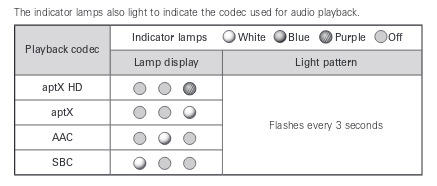
An Excerpt from the User Guide regarding Bluetooth Streaming Codecs
Some readers may be interested to know that the USB wired connection may work for smartphone use. I was able to connect the headphones to my LG G6 with the USB cable by using on OTG USB-c to USB-A adapter. Initially the connection wasn't stable, but after changing the USB connection mode on the phone to one that indicated a MIDI interface, the connection became stable. I didn't investigate whether the output was truly Hi-Resolution Audio.
For a full listing of specs and features see Audio-Technica's ATH-DSR7BT product page.
Design
The design of the ATH-DSR7BT is comfortable when worn for listening, easy to use, and looks good in its conservative way. One aspect of the design I didn't like is that these headphones don't fold. Neither do the joints that allow the ear cups to swivel have adequate range in the existing degree of freedom, and could use another degree of freedom to allow for comfortable wear around the neck.
Controls
The controls are, for the most part, easy to use and ergonomic. There is one jog switch on the bottom of the left headphone that controls the volume and doubles as a next/previous track control. There is a switch on the bottom of the right headphone that controls the Bluetooth power state. The separation of these controls allows the buttons to be large and easy to find, this ease is augmented by the deep grooves in the switches.
On the bottom of the left headphone is also a touch pad, which seems a little gimmicky, that functions as a main button for play/pause for media and answer/end for phone, as well as an activation for a phone assistant with a long press. I found this button somewhat difficult to find at times and the delay between tapping the button and the resulting action to cause me to press it repeatedly, reversing the intended action.
The micro USB connection for charging and wired digital connection is also on the bottom of the left headphone which, unlike the JBL and Sennheiser, can be sealed when not in use with an attached plastic cover.
One additional control that I've never seen in headphones, even wireless headphones, is a reset button accessible through a hole similar to a SIM eject hole on mobile phones.
Feedback
Auditory feedback is provided by various musical snippets and tones as opposed to voice prompts as in the LG Tones or the other two headphones I had the opportunity to try before settling on these A-Ts. There are separate musical chimes for power state changes, Bluetooth connection state changes, low battery warning, and volume changes with a different tone when attempting to raise the volume past maximum. The volume change feedback is not available when connected in wired mode, which I could have used. Unfortunately, the low battery warning is not given in a reasonable amount of time to take action. Like the LG Tones there is a warning only immediately before the headphones power off.
There is a combined Bluetooth status - connected Bluetooth device battery meter in the system panel of the Android phone I used (an LG G6) when the headphones are connected for both phone and media audio but I found this to be inaccurate, with the headphones suddenly powering off while the meter shows some charge left. When the headphones are connected to the phone for media audio only the battery level is not incorporated in the Bluetooth status indicator.
Visual feedback on the headphones themselves is provided by three multi-color LEDs on the edge of the left headphone. Depending on the state of operation, these LEDs indicate battery level during use, battery level during charging, Bluetooth pairing or connection status, and even the Bluetooth streaming codec in use.
Comfort
The ATH-DSR7BTs are generally comfortable but in my case the ear pad recesses are neither deep enough or wide enough to be a perfect fit, requiring some adjustment when putting them on and subsequent periodic adjustment. Also, as noted above, I found the headphones to be uncomfortable to wear around my neck if I had to remove them from my ears momentarily to interact with my environment.
Durability
The durability of these headphones seems good as I accidentally dropped them while taking them off. They struck a hard floor causing a nick on a couple of the edges, but not causing any damage to the electronics or other damage to the body.
The primary band is metal with a reinforcing plastic strip with notches in the metal band fix the band adjustment. Unfortunately, every other part and sub-assembly that moves is plastic which causes an annoying creaking when handling or adjusting the headphones. This does not seem to be a good indicator of build quality.
Performance
Battery Life
Battery life is adequate for headphones of this size with a claimed up to 15 hours between charges. As a plus the headphones can be used in wired mode while charging -- this is not typically the case with Bluetooth headphones, even those that come with an analog auxiliary cable. The only issues I have with respect to the battery is that the meter displayed on the phone while paired for phone and media audio is inaccurate and like the LGs, there is a lack of a warning in a reasonable amount of time before the battery is fully depleted.
Call Audio
I must admit I haven't used the headphones for calls nearly as much as for listening to music. I found earpiece call audio quality to be good. In actual calls the microphone performed well enough that the other party never indicated problems with the audio on their end. I did have problems with the microphone in two instances however. In one instance, in a relatively quiet space, the microphone wasn't sensitive enough to register on a voice recognition system on the other end of the line. In another instance, when using Cortana on the LG G6 to dial a phone number, it took two tries because one of the numbers was misunderstood. Incidentally, the diagram in the User Guide that introduces the controls and major features of the headphones does not show the microphone.
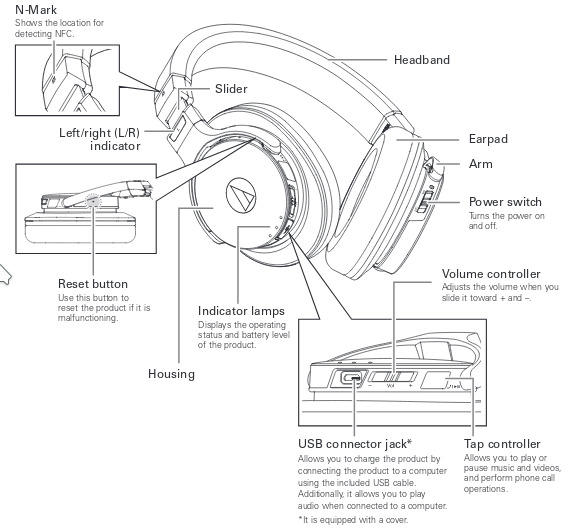
A Diagram from the User Guide Showing Controls and Components
The diagram doesn't show the microphone.
Linux
These headphones should be no problem for Linux users. I was able to connect them using Bluetooth to both openSUSE Tumbleweed with the KDE Plasma 5 desktop, and Manjaro with the Plasma 5 and Cinnamon desktops. This connection method is common these days, what was more worrisome was whether the USB connection to the computer for digital Hi-Res audio would function. This was no problem, with both Plasma 5 and Cinnamon automatically activating the Digital Stereo connection using the S/PDIF protocol standardized as IEC958.
[ 8064.336154] usb 1-6: USB disconnect, device number 6
[ 8072.651355] usb 1-6: new full-speed USB device number 7 using xhci_hcd
[ 8072.804428] usb 1-6: New USB device found, idVendor=0909, idProduct=003a
[ 8072.804430] usb 1-6: New USB device strings: Mfr=1, Product=2, SerialNumber=0
[ 8072.804430] usb 1-6: Product: ATH-DSR7BT
[ 8072.804431] usb 1-6: Manufacturer: audio-technica
[ 8072.808016] hid-generic 0003:0909:003A.0004: hiddev96,hidraw1: USB HID v1.00 Device [audio-technica ATH-DSR7BT] on usb-0000:00:14.0-6/input2
When connected, in both Manjaro and openSUSE, the USB HID then the USB audio kernel modules were loaded or activated automatically. There was a minor problem, however, when also using a Logitech USB wireless mouse in that the headphone connection seemingly caused a disruption in the mouse operation, intermittently making both keyboard and mouse input erratic. This problem is non-existent when plugging in the wireless mouse transceiver after plugging in the headphones.
-
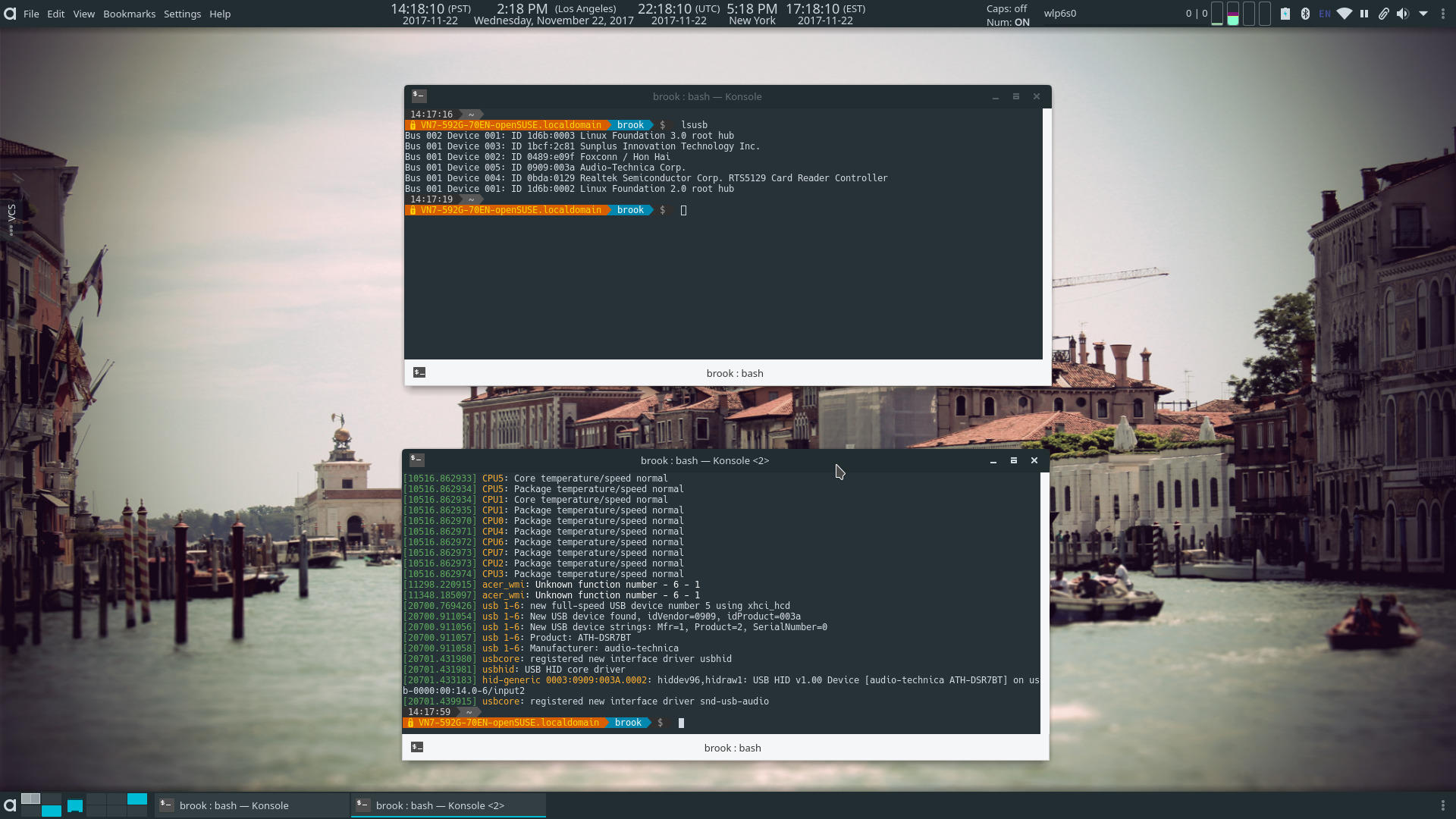
The Outputs of lsusb and dmesg on openSUSE Tumbleweed with the Plasma 5 DE.
The headphones are first registered as a USB HID and then as a USB sound device.
-

KDE Plasma 5's Extensive Settings in the Expanded Notification Shows the Digital Connection.
-
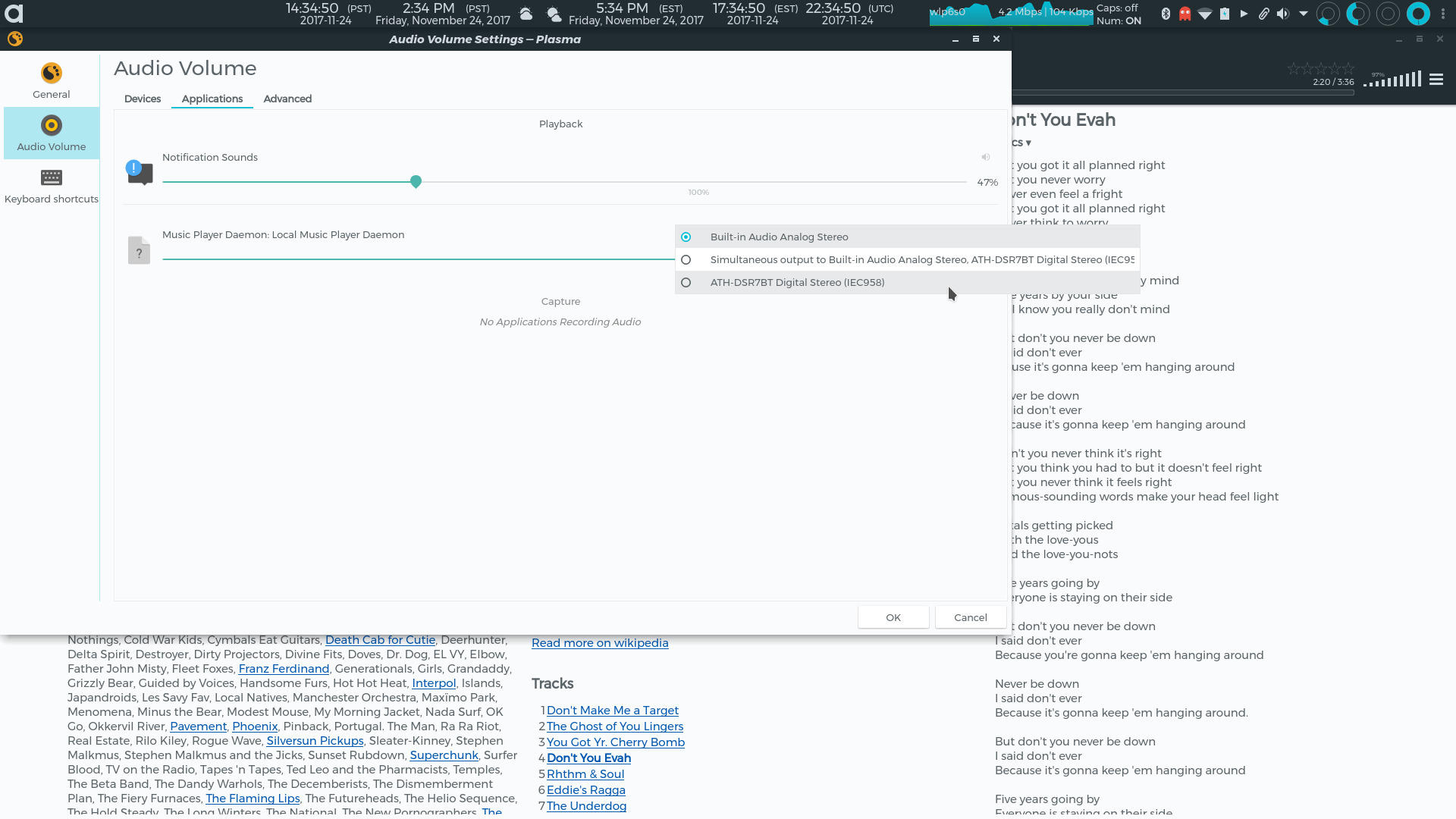
Selecting the ATH-DSR7BT Mode When Connected by USB
It seems an Analog Stereo Mode is available as well as a Digital Stereo Mode conforming to the standardization of S/PDIF in IEC958.
-

The Cinnamon Desktop Settings Showing the available Digital Stereo and Analog Stereo Connections.
-
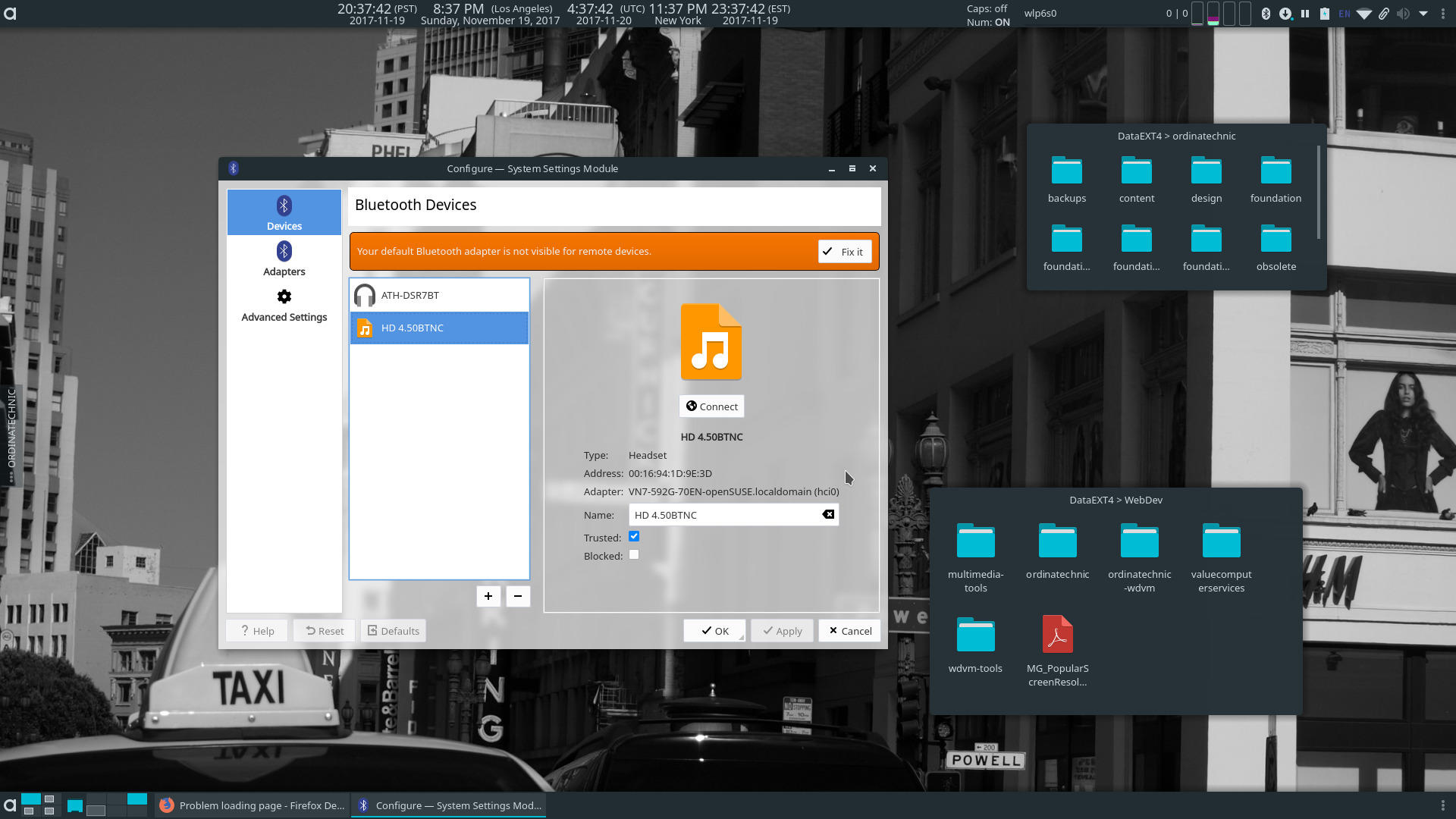
Connecting to PLasma 5 on openSUSE Tumbleweed with Bluetooth
The Papirus icon set provides an icon for the Audio-Technica ATH-DSR7BT but not the Sennheiser 4.50 BTNC.
Connecting the Audio-Technica ATH-DSR7BT to a Linux Desktop
Accessories
Audio-Technica provides the bare minimum in accessories, consisting of a carrying pouch and a high quality shielded USB cable. The pouch has a very soft and smooth interior surface and a neoprene like outer surface. A hard case like the very impressive one provided by JBL for Everest Elite 750NC would have been nice, but barring that, I would have preferred a pouch with an interior or exterior pocket for the USB cable. A full printed user guide is also provided as opposed to just a quick start guide.
I also missed a companion app for these headphones. All of the headphones I mentioned in this review as having tried, my previous LGs, and the BOSE SoundSport had companions apps with varying functionality.
Sound Quality
Sound characteristics are exactly what I was looking for in terms of balanced levels throughout the spectrum, which the JBLs and to a lesser extent, the Sennheiser did not have. Some of my subjective observations of these A-Ts:
-
External noise isolation is minimal.
-
I found the loudness level when connected to my laptop by USB cable to be SIGNIFICANTLY lower than when connected by Bluetooth. Whatever the difference in technical quality between the two connection methods, listening with a Bluetooth connection was much more enjoyable. Whether this is a limitation in the Linux drivers needed for the Digital Stereo connection -- unlikely, interference with other UBS related modules, a limitation of the headphones or something else, I don't know.
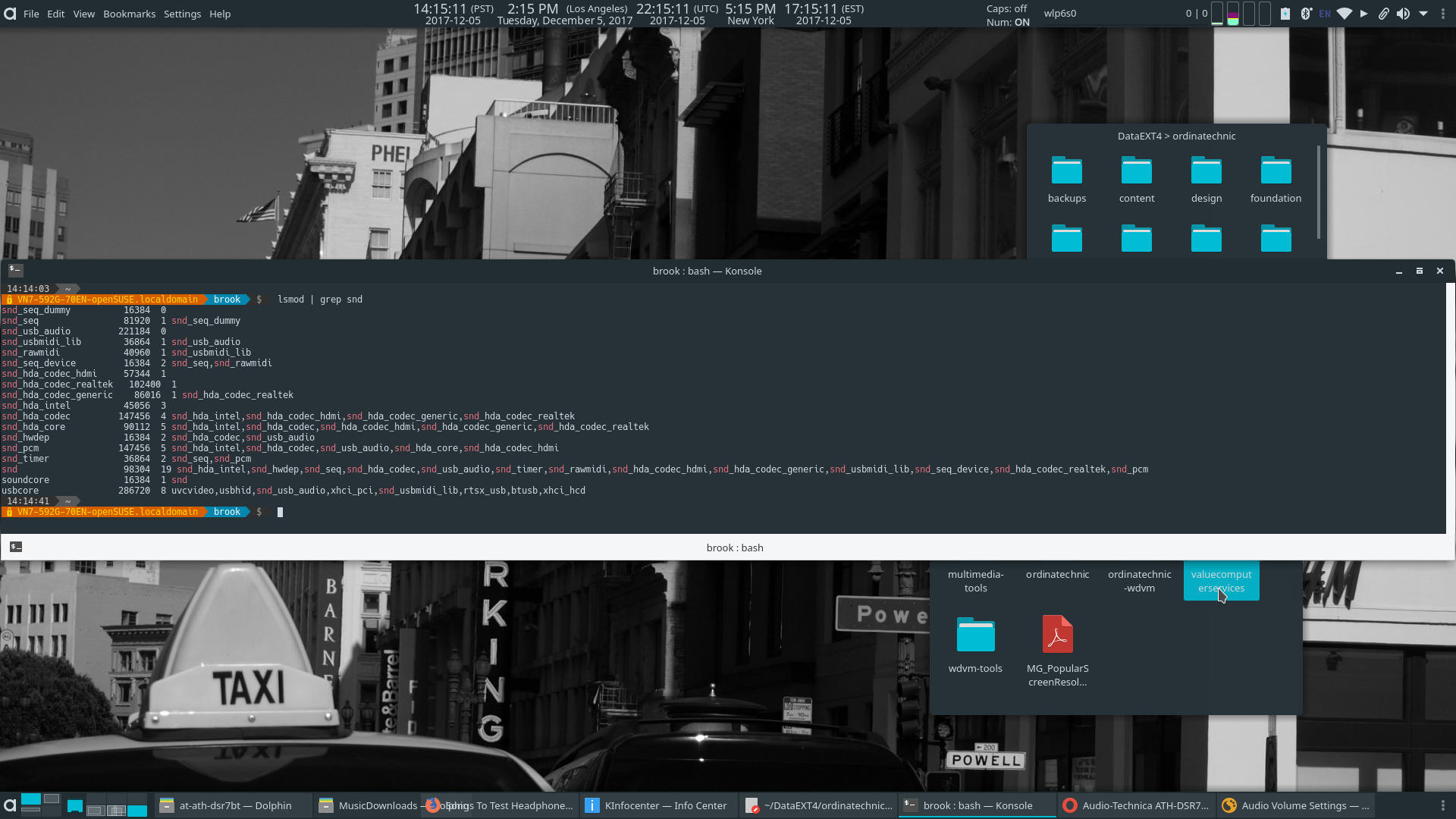
Loaded Kernel Modules Related to Sound
One of the loaded modules is snd-usb-audio and others that are related to be Intel High Definition Audio.
-
The difference in a high quality audio file such as those provided by Spotify's playlist for testing headphones and the 253kbps mp3 files that make up the majority of my collection was very noticeable, initially. I found the difference especially impressive when comparing the version of People are People by Depeche Mode [2006 Remastered] and the same track in my collection the first time I listened to these two versions back to back. Somehow, not so much in subsequent comparisons.
-
The superior sound quality of these headphones was also evident when comparing playback of Delphic's Halcyon on the ATH-DSR7BT and on the LG HBS-1100. Although the sound quality of the LGS were good, with the balanced sound that I prefer, on this song in particular it's weakness was apparent in the almost harsh hissing reproduction of Delphic's Ses. This is almost completely not apparent in the Audio-Technicas.
-
In Empathy by Crystal Castles, a song with a prominent pure and processed bass drum as well as deep transient synthesizer notes, the quality of the headphones is evident. The bass kicks are strong, but un-emphasized and unlike with the LG Tone Platinum some of the processed bass drum kicks that sustain and fade out don't sustain as long. I'm assuming the reproduction by the A-Ts are closer to the reality.
-
In Counterpoint by Delphic, the S in the phrase "nothing's wrong" was an extremely harsh hiss when on the LG Tone Platinum (HBS-1100). On these A-T's most of the harshness is gone and the S in the phrase "nothing's wrong" sound more like Zs.
Recommendation
I could have gone and on with my observations on the sound quality but I will just end my observations with saying that I am very impressed with these headphones. You should be convinced of this by the fact I returned both the JBL Everest Elite 750NC and the Sennheiser 4.50BTNC to get these. I highly recommend the ATH-DSR7BTs to those who demand from their headphones faithful reproduction of recorded audio such that as much nuance and texture is discernible in each instrument and a natural sound in a way that is not provided by popular models from other manufacturers -- although the sound of these popular models are pleasing. Anyone who would rather have a strong and emphasized bass to the point that the sound is unnatural and unbalanced will be disappointed.